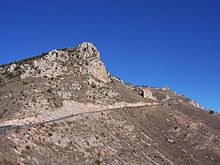Battle of Monte Laturce

The Battle of Monte Laturce, also known as the second Battle of Albelda, was a victory for the forces of
The
The
The rout of Monte Laturce is usually dated to 859[5] or 860.[6] The only source which may directly speak of Monte Laturce under the year 859 is Ibn al-Athir, who wrote that in 245 AH (which began 7 April 859) the Muslim governor of Tarazona (who is known to have been Musa at the time) invaded the Kingdom of Navarre and captured a Christian castle, taking its inhabitants prisoner. The next day he was defeated in battle and many Muslims lost their lives.
The Chronicle of Alfonso III records that, after the Battle of Albelda in 851, and partly by means of war, partly by treachery, Musa captured two Frankish leaders, Sancho and Emenon,[7] whom he threw into a dungeon. The date of Sancho and Emenon's capture is not given. The "gifts" from Charles the Bald which Ordoño's soldiers found in the camp of Musa at Monte Laturce may have been the ransom paid for Sancho and Emenon, in which case their capture occurred prior to 859/60.
Notes
- ^ This story is found in all extant versions of the Chronicle and is likely to be original and unmodified by later copyists and redactors.
- ^ The French Orientalist Évariste Lévi-Provençal argued that Tudela, traditional stronghold of the Banu Qasi, was meant, but Claudio Sánchez-Albornoz defended the Chronicle.
- ^ Claudio Sánchez-Albornoz, "La auténtica batalla de Clavijo", Cuadernos de Historia de España, 9:94–139, reprinted in Orígenes de la nación española, III (Oviedo: 1975), 281–311, cited in Richard A. Fletcher (1984), Saint James's Catapult: The Life and Times of Diego Gelmírez of Santiago de Compostela (Oxford: Oxford University Press), 67.
- ^ This may be the aforementioned García.
- ^ Pérez de Urbel, 26 note 1, collects the references: Claudio Sánchez-Albornoz, La auténtica batalla de Clavijo, 117ff.; P. Tailhan (1885), Anonyme de Cordoue, 196; M. Gómez-Moreno (1917), Anales Castellanos, 11–2; and Lucien Barrau-Dihigo (1921), "Recherches sur l'histoire politique du Royaume Asturien," Revue Hispanique, 52:180, note 2.
- ^ Pérez de Urbel, 26 note 1, collects the references: Reinhart Dozy, Recherches, I, 214 and A. Fernández Guerra (1883), Caída y ruina del imperio visigodo español, 27.
- ^ In the Chronicle, read "Emenonem" for "Epulonem".
References
- Cañada Juste, Alberto. 1980. "Los Banu Qasi (714–924)", Príncipe de Viana, 41: 5-96.
- Pérez de Urbel, Justo. 1954. "Lo viejo y lo nuevo sobre el origen del Reino de Pamplona". Al-Andalus, 19:1–42, especially 20–6.
